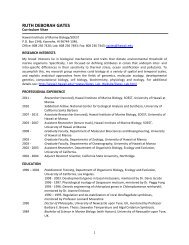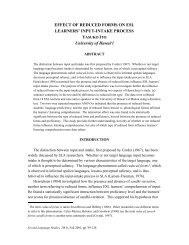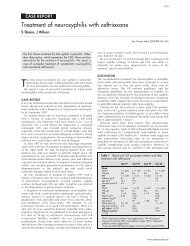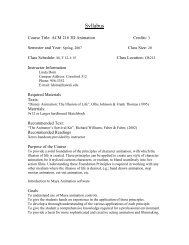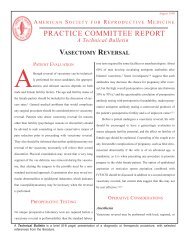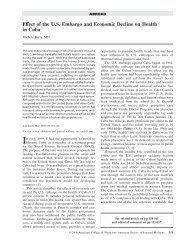Tying and Untying the Trouser-Cord - University of Hawaii
Tying and Untying the Trouser-Cord - University of Hawaii
Tying and Untying the Trouser-Cord - University of Hawaii
Create successful ePaper yourself
Turn your PDF publications into a flip-book with our unique Google optimized e-Paper software.
66 J. W. Frembgen<br />
is mentioned only once in passing without any notion <strong>of</strong> its meaning (Lindisfarne-Tapper &<br />
Ingham 1997, p. 74).<br />
[2] But comparative meanings <strong>and</strong> uses <strong>of</strong> belts <strong>and</strong> strings are also found in Hinduism. Part <strong>of</strong><br />
<strong>the</strong> upanayana ritual <strong>of</strong> <strong>the</strong> twice-born is, for instance, <strong>the</strong> girdling <strong>of</strong> <strong>the</strong> boy with a special<br />
holy grass (darbha) consisting <strong>of</strong> three strings (Dubois 1994[1906], pp. 181, 186). In this way,<br />
<strong>the</strong> body <strong>of</strong> <strong>the</strong> chaste brahmacarin is symbolically separated into two pieces: <strong>the</strong> upper part<br />
(head <strong>and</strong> heart) should study <strong>the</strong> Veda, whereas <strong>the</strong> lower, impure part is reserved for<br />
excretions.<br />
[3] See index*/shadd, trousers <strong>of</strong> <strong>the</strong> futuwwa<br />
[4] In her chapter on ‘Loincloth <strong>and</strong> celibacy’, Kirin Narayan, for instance, mentions ascetics<br />
wearing, in similar fashion to <strong>the</strong> European ‘chastity belt’, ‘a wooden belt several inches thick<br />
<strong>and</strong> locked with brass hinges (kathiya babas), <strong>and</strong> ascetics who live encased in metal loincloths<br />
<strong>of</strong> iron, steel, or brass’ (1989, p. 120).<br />
[5] According to religious law, <strong>the</strong> bride has <strong>the</strong> right to share her husb<strong>and</strong>’s bed every night<br />
during <strong>the</strong> first seven days <strong>of</strong> <strong>the</strong>ir marriage (Omar 1989, p. 48; cf. Spring & Hudson 1995, p.<br />
76; Kammerer-Grothaus 1995, p. 6, cf. 35, 38 (nos. 31 /2); Chebel 1997, p.163). In ano<strong>the</strong>r<br />
context, among <strong>the</strong> Berber tribe <strong>of</strong> <strong>the</strong> Ulad Bu ‘Aziz, <strong>the</strong> belt <strong>of</strong> a woman symbolises a<br />
shameful submission <strong>and</strong> pledge. It is said that:<br />
if a sheikh or governor wants to extract money from one <strong>of</strong> his subjects <strong>and</strong> <strong>the</strong><br />
latter takes refuge in <strong>the</strong> tent <strong>of</strong> some important person who happens to be away<br />
from home, <strong>the</strong> wife <strong>of</strong> <strong>the</strong> absent host takes <strong>of</strong>f her belt (hzäm) <strong>and</strong> gives it to<br />
<strong>the</strong> refugee, who goes with it to <strong>the</strong> sheikh or governor. This is ‘ar [shame;<br />
author’s note] on <strong>the</strong> part <strong>of</strong> <strong>the</strong> wife, <strong>and</strong> one-half <strong>of</strong> <strong>the</strong> claim will be remitted<br />
in consequence. (Westermarck 1926, p. 521)<br />
[6] This happens, for example at <strong>the</strong> shrines <strong>of</strong> <strong>the</strong> Algerian saints Sidi Bu ‘Abdallah in Quarizane<br />
<strong>and</strong> Lalla Setti in Tlemcen (Dermenghem 1954, pp. 99, 129, 133). In a similar context, Algerian<br />
Berber women <strong>of</strong> Greater Kabylia, who suffer from infertility, fasten <strong>the</strong>ir belt for a certain<br />
time to <strong>the</strong> main horizontal beam <strong>of</strong> <strong>the</strong> home (Neumann 1983, p. 93). They do so to charge it<br />
so to speak with <strong>the</strong> power <strong>of</strong> fertility embodied in this part <strong>of</strong> <strong>the</strong> domestic architecture<br />
considered to symbolise <strong>the</strong> male principle <strong>and</strong> to be associated to <strong>the</strong> activities <strong>of</strong> <strong>the</strong> sky.<br />
[7] In India shalwar-qamiz has nowadays become a modern functional garment particularly<br />
accepted by young women.<br />
[8] In Pashto this tube-like seam is called bada or da bagay tilay.<br />
[9] In Muslim countries in South, West, <strong>and</strong> Central Asia, <strong>the</strong> trouser-cord is known by different<br />
names:<br />
Urdu izar-b<strong>and</strong>, nala/nara Arabic dikkeh, dekkah<br />
Hindi nala/nala Persian izar-b<strong>and</strong><br />
Punjabi nala/nara Tajik ezar, ezar-b<strong>and</strong><br />
Hindko nara Turkish uçkur<br />
Gujerati naro Turkmen urguch<br />
Pashto parthoghakh, baga Uighur ishtan-bagh<br />
Burushaski ghaski<br />
Interestingly <strong>the</strong> homonymous expression nala/nara is also <strong>the</strong> term for a water channel, a rivulet,<br />
<strong>and</strong> <strong>the</strong> umbilical cord; in Hindi <strong>the</strong> navel-string is called nal. This homonym might provide a hint<br />
as to why in <strong>the</strong> Mewar region <strong>of</strong> Rajasthan a trouser-cord is used during <strong>the</strong> magic healing <strong>of</strong><br />
stomach pain (gola-ruti). It was explained to me that a female healer diagnoses that <strong>the</strong> navel has<br />
somewhat been displaced. For <strong>the</strong> treatment <strong>the</strong> patient first has to lie down on <strong>the</strong> floor. Then she<br />
takes a nara, ties one end around <strong>the</strong> patient’s toe <strong>and</strong> takes <strong>the</strong> o<strong>the</strong>r one in her h<strong>and</strong>, reciting<br />
special mantra s (sacred formulas).



